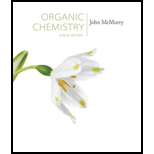
Concept explainers
Interpretation:
Given that the third and fourth steps in the synthesis of Hagemann’s ester from ethyl acetoacetate are intramolecular aldol cyclization to yield a substituted cyclohexenone and a decarboxylation reaction. Both reactions are to be shown and products of each step are to be shown.
Concept introduction:
In intramolecular aldol reactions dicarbonyl compounds such as diketones react with a base to yield a cyclic enone as the products. The reaction occurs in three steps i) Abstraction of α-hydrogen by a base to yield an enolate anion ii) Attack of the anion on the carbonyl carbon in the same molecule iii) Protonation of the alkoxide intermediate.
A β-ketoacid normally eliminates CO2 on heating.
To show:
The third and fourth steps in the synthesis of Hagemann’s ester from ethyl acetoacetate, the intramolecular aldol cyclization to yield a substituted cyclohexenone and a decarboxylation reaction and further to show the products of these reactions.
Trending nowThis is a popular solution!

Chapter 23 Solutions
Organic Chemistry
- Acid-catalyzed hydrolysis of the following epoxide gives a trans diol. Of the two possible trans diols, only one is formed. How do you account for this stereoselectivity?arrow_forwardA step in a synthesis of PGE1 (prostaglandin E1, alprostadil) is the reaction of a trisubstituted cyclohexene with bromine to form a bromolactone. Propose a mechanism for formation of this bromolactone and account for the observed stereochemistry of each substituent on the cyclohexane ring. Alprostadil is used as a temporary therapy for infants born with congenital heart defects that restrict pulmonary blood flow. It brings about dilation of the ductus arteriosus, which in turn increases blood flow in the lungs and blood oxygenation.arrow_forwardThe following reactivity order has been found for the saponification of alkyl acetates by aqueous NaOH. Explain. CH3CO2CH3 > CH3CO2CH2CH3 > CH3CO2CH(CH3)2 > CH3CO2C(CH3)3arrow_forward
- Give all the reagents and steps to carry out the following synthesis? No mechanisms Required.arrow_forwardPredict the expected product for each reaction and provide IUPAC name for the correct starting material to yield the desired epoxide:arrow_forwardPropose a mechanism for the reaction of benzoic acid with oxalyl chloride. This mechanismbegins like the thionyl chloride reaction, to give a reactive mixed anhydride. Nucleophilicacyl substitution by chloride ion gives a tetrahedral intermediate that eliminates a leavinggroup, which then fragments into carbon dioxide, carbon monoxide, and chloride ion.arrow_forward
- How would you carry out the following transformations Indicate the appropriate reagents in each case.arrow_forwardPredict the major monoalkylation products you would expect to obtain from reactionof the following substances with, chloromethane and AlCl3:(a) Bromobenzene(b) m-Bromophenol(c) p-Chloroaniline(d) 2, 4-Dichloronitrobenzene(e) 2, 4-Dichlorophenol(f) Benzoic acid(g) p-Methylbenzenesulfonic acid(h) 2, 5-Dibromotoluenearrow_forwardThe Baylis–Hillman reaction is a DABCO (1,4-diazabicyclo[2.2.2]octane) catalyzed reaction of an a,b-unsaturated carbonyl compound with an aldehyde toform an allylic alcohol. Propose a mechanism for the reaction. (Hint: DABCO serves as both a nucleophile and as a base in the reaction.)arrow_forward
- Friedel–Crafts alkylations can be carried out with carbocations formed from reactions other than the reaction of an alkyl halide with AlCl3. Propose a mechanism for the following reaction:arrow_forwardWhat products are obtained by hydration of the symmetrical alkyne shown below? Show the mechanism.arrow_forwardWhich following reagents is expected to give the indicated product in high yield?arrow_forward

 Organic ChemistryChemistryISBN:9781305580350Author:William H. Brown, Brent L. Iverson, Eric Anslyn, Christopher S. FootePublisher:Cengage Learning
Organic ChemistryChemistryISBN:9781305580350Author:William H. Brown, Brent L. Iverson, Eric Anslyn, Christopher S. FootePublisher:Cengage Learning

